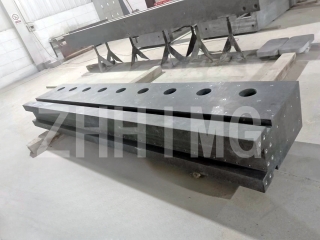Multiple reasons why perovskite coating machines rely on granite bases
Outstanding stability
The perovskite coating process has extremely high requirements for equipment stability. Even the slightest vibration or displacement can lead to uneven coating thickness, which in turn affects the quality of perovskite films and ultimately reduces the photoelectric conversion efficiency of the battery. Granite has a density as high as 2.7-3.1g/cm³, is hard in texture, and can provide stable support for the coating machine. Compared with metal bases, granite bases can effectively reduce the interference of external vibrations, such as the vibrations generated by the operation of other equipment and the movement of personnel in the factory. After being attenuated by the granite base, the vibrations transmitted to the core components of the coating machine are negligible, ensuring the stable progress of the coating process.
Extremely low coefficient of thermal expansion
When the perovskite coating machine is in operation, some components will generate heat due to the work done by current and mechanical friction, causing the equipment temperature to rise. Meanwhile, the ambient temperature in the production workshop may also fluctuate to a certain extent. The size of common materials will change significantly when the temperature varies, which is fatal for perovskite coating processes that require nanoscale precision. The coefficient of thermal expansion of granite is extremely low, approximately (4-8) ×10⁻⁶/℃. When the temperature fluctuates, its size changes very little.

Good chemical stability
Perovskite precursor solutions often have certain chemical reactivity. During the coating process, if the chemical stability of the equipment base material is poor, it may undergo a chemical reaction with the solution. This not only contaminates the solution, affecting the chemical composition and performance of the perovskite film, but also may corrode the base, shortening the service life of the equipment. Granite is mainly composed of minerals such as quartz and feldspar. It has stable chemical properties and is resistant to acid and alkali corrosion. When it comes into contact with perovskite precursor solutions and other chemical reagents in the production process, no chemical reactions occur, ensuring the purity of the coating environment and the long-term stable operation of the equipment.
High damping characteristics reduce the impact of vibration
When the coating machine is in operation, the movement of internal mechanical components can cause vibration, such as the reciprocating motion of the coating head and the operation of the motor. If these vibrations cannot be attenuated in time, they will propagate and superimpose inside the equipment, further affecting the coating accuracy. Granite has a relatively high damping characteristic, with a damping ratio generally ranging from 0.05 to 0.1, which is several times that of metallic materials.
The technical mystery of achieving ±1μm flatness in a 10-span gantry frame
High-precision processing technology
To achieve a flatness of ±1μm for a 10-span gantry frame, advanced high-precision processing techniques must be adopted first in the processing stage. The surface of the gantry frame is finely treated through ultra-precision grinding and polishing techniques.
Advanced detection and feedback system
In the manufacturing and installation process of gantry frames, it is crucial to be equipped with advanced detection instruments. The laser interferometer can measure the flatness deviation of each part of the gantry frame in real time, and its measurement accuracy can reach the sub-micron level. The measurement data will be fed back to the control system in real time. The control system calculates the position and quantity that need to be adjusted based on the feedback data, and then adjusts the gantry frame through a high-precision fine-tuning device.
Optimized structural design
Reasonable structural design helps to enhance the rigidity and stability of the gantry frame and reduce deformation caused by its own weight and external loads. The structure of the gantry frame was simulated and analyzed by using the finite element analysis software to optimize the cross-sectional shape, size and connection method of the crossbeam and column. For instance, crossbeams with box-shaped cross-sections have stronger torsional and bending resistance compared to ordinary I-beams, and can effectively reduce deformation at a 10-meter span. Meanwhile, reinforcing ribs are added at key parts to further enhance the rigidity of the structure, ensuring that the flatness of the gantry frame can still be maintained within ±1μm when subjected to various loads during the operation of the coating machine.
Selection and processing of materials
The granite base of the perovskite coating machine, with its stability, low coefficient of thermal expansion, chemical stability and high damping characteristics, provides a solid foundation for high-precision coating. The 10-span gantry frame has achieved an ultra-high flatness of ±1μm through a series of technical means such as high-precision processing techniques, advanced detection and feedback systems, optimized structural design, and material selection and treatment, jointly promoting the production of perovskite solar cells to move towards higher efficiency and higher quality.
Post time: May-21-2025

